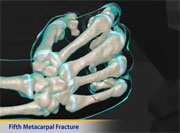
Boxer's Fracture
What is a boxer’s fracture?
A boxer’s fracture is a break in the bone in the hand that attaches to the pinky finger. The long bones in the hand are called metacarpals. A boxer’s fracture is also called a fifth metacarpal fracture.
A child's bones are different than adults in some important ways. First, the bones of a child are more flexible. Sometimes the bones crack like green branches from a live tree instead of snapping like a dry stick. Other times the bones just buckle slightly. When this happens, the bone is broken but there isn't a clear fracture line just a slightly raised area on the outside of the bone. The second major difference is that a child's bones are still growing. Bones grow from an area near their ends called the growth plate. Sometimes fractures occur within the growth plate and can be difficult to see on an X-ray. Fractures in this area can affect the growth of the bone and may require special X-rays or other tests.
How does it occur?
A boxer’s fracture usually occurs when your child hits a hard object with his or her fist. That is why it is called a boxer's fracture. It can also occur if your child falls onto the hand.
What are the symptoms?
Symptoms include pain, swelling, and tenderness on the pinky finger side of the hand. There may be a bump on the side of your child's hand or it may look crooked.
How is it diagnosed?
Your child's healthcare provider will review the symptoms, ask how the injury happened, and look at the hand. Your child's provider will take an X-ray of the hand, which will show the break.
How is it treated?
If the broken bone is crooked your child's provider will straighten it. Then a cast or splint will be placed from the hand to the forearm. The cast or splint will need to stay on for 4 to 6 weeks.
Treatment will also include:
- Elevating your child's hand by placing it on a pillow during sleep or the back of a couch when sitting down.
- Putting an ice bag over the cast or splint for 20 to 30 minutes every 3 to 4 hours for the first 2 to 3 days.
- Taking anti-inflammatory medicine or other medicine prescribed by your child's provider.
Fifth metacarpal fractures usually heal within 6 weeks.
When can my child return to normal activities?
Everyone recovers from an injury at a different rate. Return to your child's activities depends on how soon the hand recovers, not by how many days or weeks it has been since the injury occurred. The goal is to return them to normal activities as soon as safely possible. If your child returns too soon the injury may get worse. Your child may start rehabilitation exercises when the healthcare provider has taken a follow-up X-ray sees that the fracture has healed.
Your child may return to normal activities when the hand has full range of motion without pain and has the same strength as the uninjured hand.
When should I call my child's health care provider?
Call immediately or go to the emergency room if:
- Your child has increased pain, redness, warmth, or swelling.
- Your child has a loss of sensation in the hand or fingers.
- The injured hand looks pale, blue, or feels cold.

